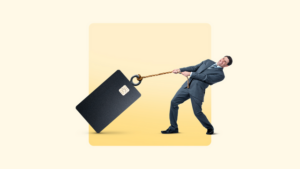Do you have too much debt?

Key takeaways
- Your debt-to-income ratio (DTI) can quickly determine if you have too much debt.
- Good debt, like a mortgage or student loans, can increase your net worth, while bad debt, like credit card debt, does not provide any value.
- Options for managing too much debt include a DIY approach, credit counseling, debt consolidation loans, and debt settlement programs.
According to Bankrate’s 2025 Money and Mental Health Survey, almost half of U.S. adults (47 percent) say that money has a negative impact on their mental health. Nearly half (47 percent) of those say debt is one of the leading causes of this negative impact.
Unfortunately for Americans, debt is so common that it can be easy to dismiss or see rapid debt accrual as a necessary part of life. This is evident in Americans’ 2024 spending habits; credit card debt saw a total balance increase of 8.6 percent, and total consumer debt grew by 2.4 percent from 2023 to 2024, according to an Experian study released in January 2025.
If you’re living paycheck-to-paycheck, with most of your earnings going toward debt, those could be warning signs of debt problems. While chipping away at those balances may feel overwhelming, know that with hard work, dedication and patience, you can become debt-free.
How to know if you have too much debt
One of the quickest ways to determine whether debt is becoming an issue is to calculate your debt-to-income ratio (DTI). Your DTI measures how much debt you have relative to your monthly gross income, expressed as a percentage.
You can calculate this manually by adding up all of your monthly debt payments in your credit report — auto loans, personal loans, student loans, credit cards and mortgages, among others — and dividing that amount by your monthly gross income.
Money tip: You can use a calculator to find your exact DTI instead of crunching numbers manually. Using a calculator is also the best way to reduce any room for error.
Typically, lenders like to see a DTI under 36 percent. So, if your monthly gross income is $3,000, your monthly debt payments shouldn’t exceed $1,050.
Warning signs your debt could be a problem
Greg McBride, Bankrate chief financial analyst, says that one simple way of knowing if your debt is becoming a problem is if your total balances are going up every month instead of coming down.
If you’re continually adding to your debt rather than making consistent progress on paying down the balances, you’re headed down the wrong path financially. Another clear red flag that you may be carrying too much debt is if your total payments for non-mortgage debt exceed 15 percent of your monthly gross income.— Greg McBride, Bankrate Chief Financial Analyst
For example, assuming you make a gross monthly income of $3,000, your credit cards, auto loan, and other non-mortgage debt payments shouldn’t exceed $450 a month when combined.
Other warning signs of debt problems may include:
- Not remembering how much you owe and to who off the top of your head.
- Borrowing money to make payments on other debts.
- Relying on credit cards to make everyday purchases.
- Making only the minimum payment due on your cards.
- Not having an emergency fund and being unable to establish one.
- Not being able to contribute to your retirement savings.
Good vs. bad debt
While there are many different kinds of debt, not all debts are necessarily bad for your overall financial health. Debt that can increase your net worth over time or that ends with a positive return can benefit your financial future.
Bad debt does exist, however, and it should be avoided whenever possible. For example, high-interest debt accrual — like credit cards, payday loans and high-interest personal loans — won’t benefit your wallet in the long run.
Good debt
Good debt increases your net worth over time or has lasting value. Examples of good types of debt include mortgages and student loans. Residential property or houses generally appreciate over time and are considered a good investment because if you sell, you may get back more than you put in.
Additionally, a college degree enables you to get a well-paying job and earn more money throughout your life. According to the U.S. Bureau of Labor Statistics, U.S. adults with a GED or high school diploma only earn about 60 percent of what those who hold a bachelor’s degree earn on a weekly basis.
However, this doesn’t apply to all career fields, as certain positions yield higher starting salaries. Before assuming your loans are automatically a ‘good’ debt, consider your degree’s predicted return on investment (ROI) compared to your total student debt load.
Bad debt
Bad debt, on the other hand, doesn’t provide any type of value. It includes things you finance because you don’t have the cash to pay for them. Unlike good debt, it doesn’t add to your net worth or have lasting value.
Bad debt includes carrying balances on credit cards, auto loans and payday loans. It’s considered “bad” debt because, typically, these balances carry no benefit but come with high fees and rates.
Why does high debt matter?
Having too much debt, particularly bad debt, suggests that you may be living beyond your means. This can make you seem like a riskier borrower in the eyes of lenders, as this makes you more likely to default than someone with a lower debt load.
“Too much debt, and the wrong kind of debt, will stand in the way of making financial progress,” McBride says.
“You won’t be saving for retirement or emergencies to the extent you should. Your credit rating will suffer if you’re increasingly indebted, limiting your ability to get better interest rates, impacting your auto insurance premiums, ability to rent an apartment, or even to get certain jobs.”
The more debt you have — particularly bad debt — the more likely you are to fall victim to the vicious debt cycle. You may need to take out more high-interest debt to repay your existing debts. Plus, more debt means that your DTI ratio is high, making it harder to get approved for loans.
What to do if you have too much debt
If your debt is affecting your day-to-day life, consider the following options. Remember that debt relief shouldn’t be a one-size-fits-all approach, so be patient and try out different methods. Paying down your debt also takes time, so give the following methods time before throwing in the towel.
DIY approach
The DIY approach can be a good option if your main concern is credit card debt. Only those with an established budget and the ability to maintain the repayment plans through the end of their loan balance should pursue this route. Missing just a few payments could derail your progress as interest will continue to accrue.
There are two main repayment options to approach when tackling your debt on your own: the snowball and the avalanche methods.
The snowball payoff strategy consists of making a list of all your debts and paying them in ascending order. In other words, you will first concentrate on paying the one with the smallest balance — regardless of its interest rate — and move up from there. The snowball strategy is better suited for those who need a psychological push and have multiple accounts with similar rates.
On the other hand, the avalanche payoff strategy focuses on paying off the account with the highest interest rate first — regardless of its balance — to save more money down the line. The avalanche strategy may be better for those with debts with significantly higher rates than other accounts who want to prevent further interest accrual.
With both methods, you’ll focus on paying down one debt at a time but will continue making the minimum payments on the remainder of the debts.
Who it’s better for: Borrowers that have a strong budget and spending habits to continue the repayment method until the debt is cleared.
Credit counseling
“If you need help budgeting and managing your debts, contact a nonprofit credit counseling agency. They have trained counselors that can help map out a budget, get on a debt repayment plan and even negotiate with creditors,” McBride says.
You can get these services through nonprofit organizations, banks, credit unions and some churches. In some cases, these entities may even offer these services for free.
There are many types of counseling services, including:
- General budgeting.
- General debt repayment.
- Debt management plans.
- Bankruptcy.
- Student loans.
- Housing, like mortgage or rent.
Who it’s better for: Those unsure how to move forward with their debt repayment options.
Debt consolidation loan
Debt consolidation loans are ideal for borrowers with a decent credit score but also larger amounts of higher-interest debt. A debt consolidation loan bundles multiple debts into a single account with a fixed repayment term and monthly payment. Your interest rate will be protected against market fluctuations as long as you choose a debt consolidation option that has a fixed rate.
While this method can result in a more organized and streamlined repayment process, it only makes sense if you’re approved for a lower rate than what you had on your previous debts. To qualify for a debt consolidation loan with a reasonable rate, you’ll need a credit score in the mid-600s or above, strong financials or a cosigner that meets these criteria.
Like all repayment methods, you’ll need to address any negative financial behaviors — if applicable — to keep your future debt accrual down. Otherwise, you may end up in a worse position than before. If you can’t repay your consolidation loan, your credit score will take a heavy hit that could take years to recover.
Who it’s better for: Borrowers with a good credit score, or qualifying cosigner, with large amounts of similar high-interest debt.
Debt settlement program
Depending on your debt’s total amount and type, you can enroll in a debt settlement program through a debt relief company. When working with a relief company, it’s possible they may recommend settling your debt, consolidating your debts or filing for bankruptcy. They also act as an intermediary by communicating with your creditors for you.
If your creditors agree to work with the relief company, you could have your debts settled for a lesser amount or forgiven altogether. However, these services come at a price, typically between 15 and 25 percent of your enrolled debts once settled. Most relief companies will also require that you stop making your payments while they negotiate with your creditors, which will inevitably cause a drop in your credit score.
There’s also the possibility that the company won’t be able to settle all your debts, leaving you with a damaged credit score and the same debt load as when you started. Plus, you’ll be financially liable for any late fees your creditors assess. That makes working with debt settlement or relief companies inherently risky, so this method should be a last-resort option before bankruptcy.
Who it’s better for: Those who have exhausted all other debt relief methods and are considering bankruptcy.
Bottom line
Having too much bad debt will follow you until you repay it. In turn, this will impact your ability to get approved for other future loans and products, making it difficult to make any positive money moves. You’ll know you’re in an uncomfortable amount of debt if you cannot make your monthly payments on a regular basis without dipping into your savings or emergency fund.
While too much debt can be overwhelming and may feel like a life sentence, you have repayment and relief options. However, each repayment method isn’t the best for every borrower, so practice patience and try out a few options until you find the best method for your current and future financial health.






